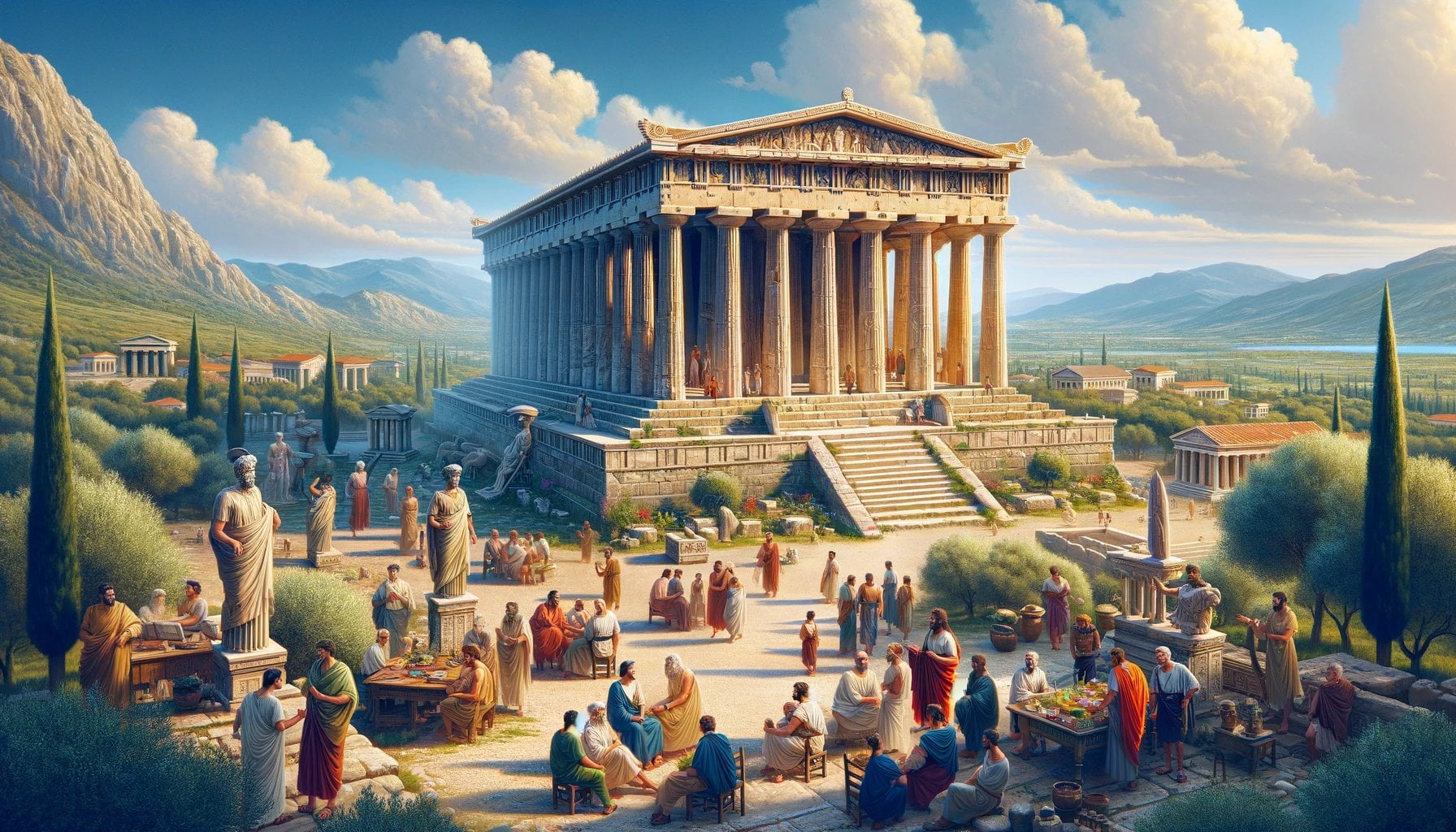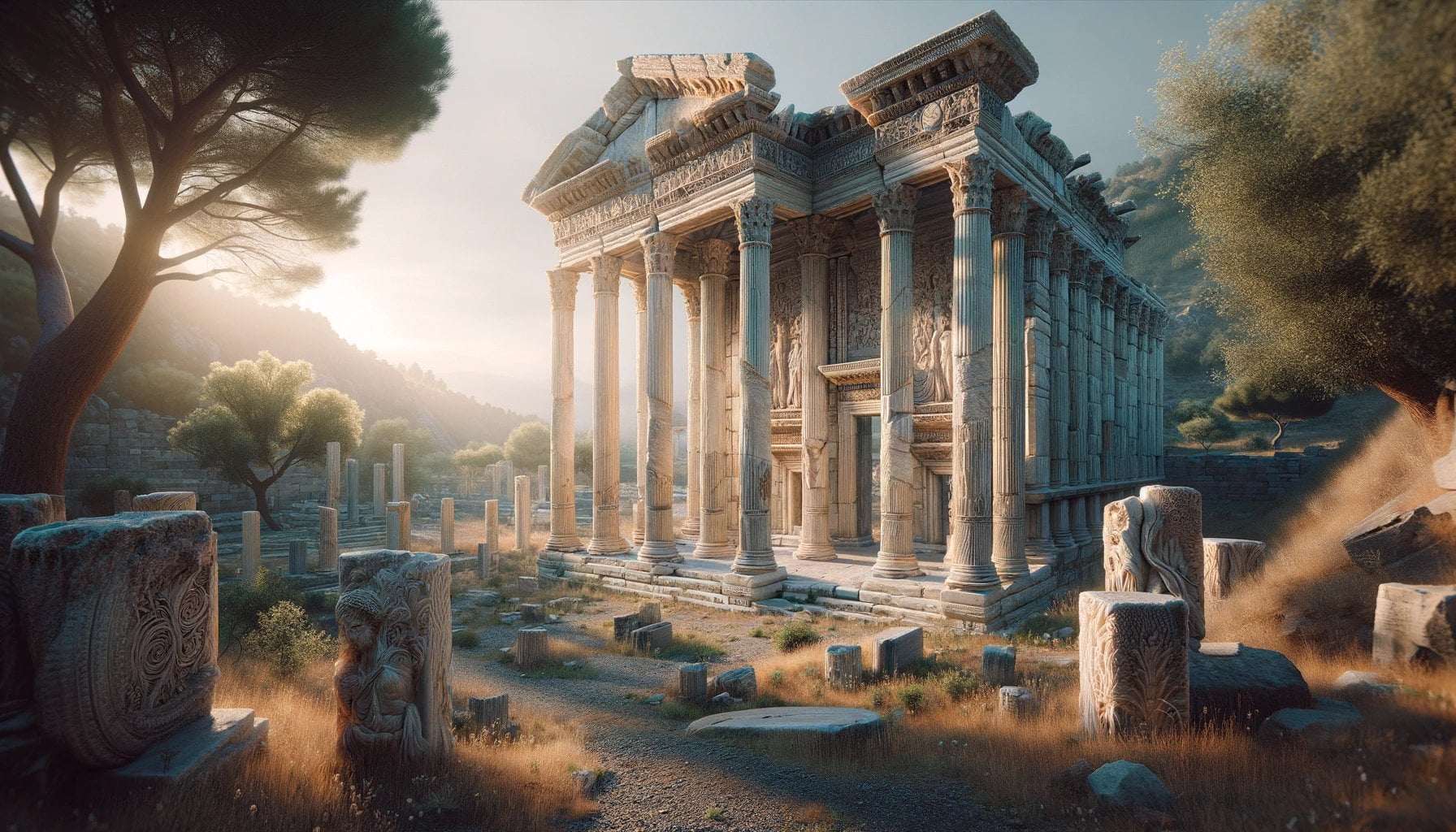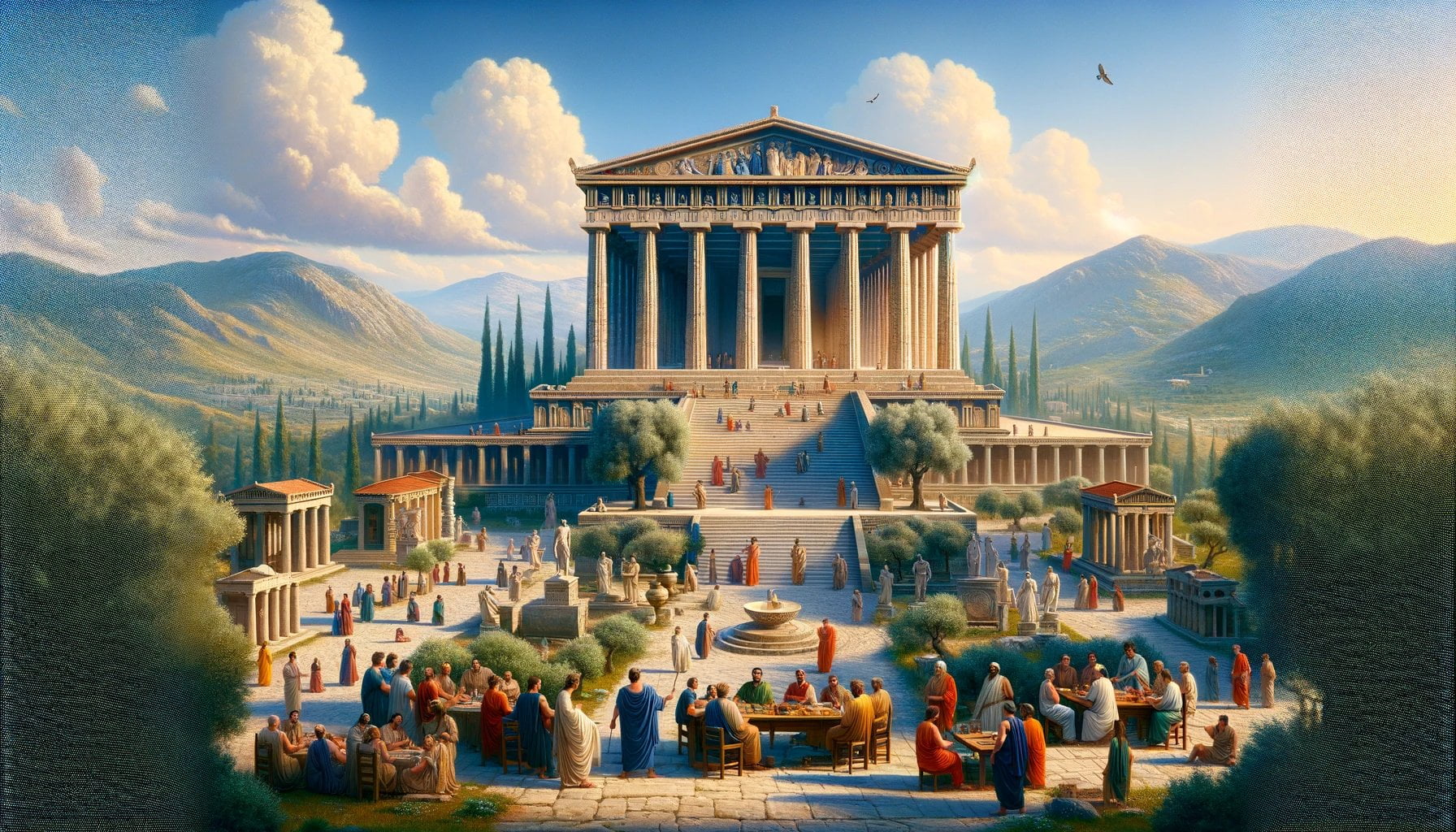Unveiling the ancient wonders of the Temple of Artemis, this article delves into the fascinating facts surrounding one of the Seven Wonders of the Ancient World. As a seasoned archaeologist, historian, and expert in ancient civilizations, I have meticulously studied and researched this iconic temple, shedding light on its significance and cultural heritage. In this comprehensive exploration, we will uncover intriguing details about the Temple of Artemis, from its intricate architectural design to its historical importance, revealing the true marvels of this ancient masterpiece.

Key Takeaways:
– The Temple of Artemis, also known as the Artemesium or the Temple of Diana, was a magnificent Greek temple dedicated to the goddess Artemis.
– It was one of the Seven Wonders of the Ancient World and was located in Ephesus, modern-day Turkey.
– The temple was built in the 6th century BCE by Croesus, the king of Lydia, and was later rebuilt after being burned down in 356 BCE.
– The Temple of Artemis was twice the size of other Greek temples and was made of stunning white marble. It featured 127 Ionic columns, standing at an impressive height of 60 feet.
– Artemis, the goddess of fertility, was the deity worshipped at the temple, making it a center of religious devotion and pilgrimage.
– The temple’s first iteration was destroyed by a flood before being rebuilt by Croesus.
– The dimensions of the Temple of Artemis were extraordinary, measuring 137 meters in length and 69 meters in width.
– It was built to honor Artemis, who was considered an Olympian God and the daughter of Zeus and Leto.
– The temple was believed to have been founded by Amazons.
– In addition to its architectural grandeur, the Temple of Artemis played a significant role as an important religious and cultural center in the lives of the people of Ephesus.
Facts about the Temple of Artemis
The Temple of Artemis, also known as the Artemesium or the Temple of Diana, is a truly remarkable structure that showcases the grandeur of ancient civilizations. Let’s delve into some intriguing facts about this magnificent wonder of the ancient world.
A Marvel of Architecture
The Temple of Artemis was built in the 6th century BCE by Croesus, the king of Lydia. Its construction marked a testament to the power and cultural achievements of the time. However, the temple faced destruction when a madman named Herostratus set it ablaze in 356 BCE. Despite this setback, it was rebuilt to become an even more extraordinary architectural feat.
The sheer scale of the Temple of Artemis is jaw-dropping. It was twice the size of other Greek temples, including the famed Parthenon, and made entirely of striking white marble. What truly made it stand out were its 127 Ionic columns, each towering to a height of 60 feet. Arranged in two rows encircling the structure, these columns gave the temple a distinctive and awe-inspiring appearance.
A Center of Worship and Devotion
Dedicated to the goddess Artemis, who is distinct from the Greek Artemis of the hunt, the temple held immense religious significance. Artemis was a goddess of fertility and occupied a powerful place in the ancient world. Her temple at Ephesus served as a sacred site of religious devotion and pilgrimage.
Additional Fascinating Points
Here are more captivating facts to enhance your understanding of the Temple of Artemis:
- The first temple faced destruction due to a flood in the 7th century BCE before being rebuilt by Croesus.
- The Temple of Artemis graced the city of Ephesus, which was entirely devoted to the worship of Artemis.
- The temple’s dimensions were truly extraordinary, measuring an astounding 137 meters in length and 69 meters in width, surpassing the size of a modern football field.
- It was constructed in honor of Artemis, the moon goddess and the daughter of Zeus and Leto, considered an Olympian God.
- According to legend, the founders of the first temple were believed to be the Amazons.
- Beyond its architectural magnificence, the Temple of Artemis played a significant role as a religious and cultural center in the lives of the people of Ephesus, attracting pilgrims from far and wide.
These fascinating facts highlight the significance and majesty of the Temple of Artemis, shedding light on its rich cultural heritage and compelling historical context.
To delve deeper into the wonders of the Temple of Artemis, you can refer to the following sources for a comprehensive exploration:
- Temple of Artemis | History & Facts | Britannica
- Temple of Artemis at Ephesus – World History Encyclopedia
Here are some fascinating facts to pique your interest about the Pentagon! Did you know that it has nearly 17.5 miles of corridors? Discover more intriguing facts about the Pentagon by clicking here.
Learn about the rich history and beauty of the Dominican Republic with these cool facts! From its stunning beaches to its vibrant culture, there’s so much to explore. Click here to find out more.
The Suez Canal is not just a waterway; it’s a marvel of engineering! Delve into its history and learn interesting facts about the Suez Canal by clicking here.
Bora Bora is a dream destination with its crystal-clear waters and lush landscapes. Discover fascinating facts about this paradise by clicking here and let your imagination take flight.
The River Jordan holds religious and historical significance. Dive into its myths, legends, and more by clicking here and unravel the mysteries of this iconic river.
Bridging the New River Gorge in West Virginia, the New River Gorge Bridge is an engineering masterpiece. Learn more about its unique design and interesting facts by clicking here and explore the wonders of this majestic bridge.
Experience the vibrant charm of Key West through these 10 intriguing facts. From its vibrant sunsets to its literary legacy, Key West has captivating tales. Click here to unravel the secrets of this enchanting island.
Dominican Republic is a treasure trove of wonders and interesting facts. Unearth 3 captivating facts about this beautiful nation by clicking here and embark on a journey of discovery.
Explore the wonders of Olympic National Park through these fun facts. From its lush rainforests to its diverse wildlife, there’s something amazing for everyone. Click here to uncover the hidden gems of this national treasure.
Let’s dive into the intriguing facts about the North Central Plains of Texas! From its distinct geological features to its rich cultural heritage, there’s so much to learn and appreciate. Click here and embark on a journey through the heart of Texas.
Significance of the Temple in Ancient Greek society
Greek temples played a vital role in ancient Greek society, serving as dedicated spaces for religious practices and honoring specific gods and goddesses. Here, we explore the significance of the Temple of Artemis and its broader importance in ancient Greek culture.
Greek Temples: Residences for the Gods
Greek temples were architectural marvels constructed within sanctuaries to house deity statues. These temples were not merely meeting places but instead served as religious spaces devoted to the worship of specific gods and goddesses. The temple interiors were designed for the performance of rituals and sacrifices rather than congregational gatherings.
Architectural Mastery and Cultural Pride
The construction and design of Greek temples were a testament to the skill and craftsmanship of ancient Greek architects. These architects meticulously planned and executed temples that showcased intricate architectural orders, such as the Doric, Ionic, and Corinthian styles. Wealthy individuals and successful military leaders sponsored and financed these temples, resulting in a sense of community pride and significance.
Honoring the Olympian Deities
Greek temples were dedicated to ouranic deities, who were gods and goddesses that resided beyond the Earth. The Temple of Artemis itself stands as a magnificent tribute to the goddess Artemis, daughter of Zeus and Leto. As a deity associated with fertility, Artemis held immense religious importance in ancient Greek society. Her temple served as a focal point for religious and cultural activities, attracting pilgrims from far and wide.
A Key Sacred Complex
Greek temples were not standalone structures but part of larger sacred complexes that included sanctuaries and altars. These complexes formed the central hubs of religious life, providing spaces for worship, offerings, and festivals. The Temple of Artemis, within the Ephesus sanctuary, exemplified a complete sacred complex, drawing worshippers and engaging them in rituals.
The Parthenon: Icon of Greek Temples
While the Temple of Artemis remains a testament to ancient Greek ingenuity, the Parthenon is considered one of the most iconic and significant Greek temples. Built atop the Acropolis in Athens, the Parthenon exemplifies the Doric architectural style and symbolizes the cultural and artistic achievements of ancient Greece. It stands as a lasting reminder of the grandeur and influence of Greek temples.
Key Takeaways:
– Greek temples were devoted religious spaces, not meeting places, built to house deity statues.
– They showcased the architectural brilliance and craftsmanship of ancient Greek architects.
– Wealthy individuals and military successes sponsored and financed the construction of these temples.
– Greek temples were dedicated to ouranic deities and formed part of larger sacred complexes.
– The Temple of Artemis, honoring the goddess Artemis, held immense religious importance.
– The Parthenon, atop the Acropolis, is an iconic Greek temple symbolizing ancient Greek achievements.
Sources:
1. Wikipedia. “Ancient Greek temple.” Link
2. ThoughtCo. “Greek Temples – Residences for the Ancient Greek Gods.” Link
Notable Events and Stories Associated with the Temple
The Temple of Artemis at Ephesus holds a captivating history filled with notable events and stories that have fascinated historians and archaeologists for centuries. Let’s explore some of the intriguing aspects and significant moments associated with this awe-inspiring ancient wonder.
The Rise and Fall of the Temple
The Temple of Artemis underwent several transformations throughout its existence. It all began in the 7th century BCE when the first temple was constructed, only to be tragically destroyed by a devastating flood. However, the city of Ephesus was determined to honor their revered goddess and rebuild the temple.
The second version of the temple emerged, surpassing its predecessor both in size and grandeur. Standing as one of the Seven Wonders of the Ancient World, it embodied architectural brilliance and religious importance. Unfortunately, its fate took a tragic turn when it was ravaged by fire, reducing it to ruins.
Self-funded by Devoted Worshipers
Remarkably, it was the Ephesians themselves who took up the monumental task of rebuilding the temple after its destruction by fire. The citizens, driven by their unwavering devotion to Artemis, pooled their resources and financed the construction of the final version of the temple. This act of collective dedication speaks volumes about the temple’s cultural significance and the deep faith of the Ephesian community.
Birthplace of Artemis
Ephesus was not chosen arbitrarily as the location for the Temple of Artemis. According to ancient beliefs, Artemis, the goddess of the moon, the hunt, the wilderness, chastity, and wild animals, was born in the vicinity of Ephesus. This proximity added to the sacredness of the temple and contributed to its elevated status among followers of Artemis.
The Temple’s Aliases
While commonly referred to as the Temple of Artemis, this magnificent structure had other names that captured different facets of its identity. It was also known as the Artemesium and the Temple of Diana. These varying titles highlight the diverse cultural influences and the wide admiration the temple garnered over time.
A Haven for Pilgrims
The Temple of Artemis served as more than just a religious site. It was a significant cultural center that attracted pilgrims from far and wide. People traveled great distances to witness its awe-inspiring architecture and pay homage to the revered goddess. The temple became a symbol of devotion and a meeting point for individuals seeking spiritual enlightenment.
The Infamous “Herostratic Fame”
One notable event associated with the Temple of Artemis is the origin of the term “Herostratic Fame.” This term emerged from the actions of a madman named Herostratus, who set the second temple ablaze in 356 BCE. His reckless act aimed at gaining personal fame forever tied his name to infamous notoriety. This incident serves as a historical reminder of the transcendent impact the temple had on individuals, regardless of their intentions.
Mysterious Demise
The final destruction of the Temple of Artemis remains somewhat of a mystery. While historical records are scarce, it is believed to have occurred in the 4th or 5th century CE. The exact circumstances and reasons behind its demise continue to elude scholars. Nonetheless, the temple’s legacy continues to captivate and fascinate enthusiasts to this day.
Key Takeaways:
- The Temple of Artemis at Ephesus underwent multiple reconstructions, with the second temple being one of the Seven Wonders of the Ancient World.
- Ephesus citizens self-funded the construction of the final version of the temple, showcasing their deep devotion and cultural significance.
- Ephesus was believed to be the birthplace of Artemis, adding to the sacredness and reverence associated with the temple.
- The temple was known by various names, including the Artemesium and the Temple of Diana, reflecting its diverse cultural impact.
- The temple attracted pilgrims from afar, serving as a significant cultural center and symbolizing unparalleled devotion.
- The infamous act of Herostratus further amplified the temple’s historical significance, leading to the coinage of the term “Herostratic Fame.”
- The exact details surrounding the temple’s final destruction remain a mystery, adding to its enduring allure.
Sources:
– Art Facts – 12 Facts About The Temple Of Artemis At Ephesus
– Study.com – Temple of Artemis | History & Facts
Legacy and Influence of the Temple of Artemis in Modern Times
The Temple of Artemis, also known as Artemesium, was not only a magnificent ancient structure but also a testament to human creativity and devotion. While the temple may no longer stand today, its legacy and influence have transcended time, leaving a lasting impact on various aspects of modern society.
Cultural Significance
One cannot underestimate the cultural significance of the Temple of Artemis. It served as a religious and cultural center, attracting pilgrims from far and wide. The temple’s dedication to the goddess Artemis, the daughter of Zeus and Leto, held immense religious importance and inspired countless worshippers. Its influence spread throughout the region, and the citizens of Ephesus funded the construction of the final version of the temple out of their devotion to Artemis.
Architectural Brilliance
The Temple of Artemis showcased the architectural brilliance and craftsmanship of ancient Greek architects. With its 127 towering Ionic columns, each reaching a height of 60 feet, the temple was a marvel of engineering and design. Its grandeur and scale set it apart from other Greek temples, and its reconstruction after it was burned down demonstrated the unwavering dedication to preserving this architectural masterpiece.
Inspiration for Art and Literature
The iconic Temple of Artemis has been a wellspring of inspiration for artists and writers throughout history. Its sheer majesty and mythical associations evoked a sense of wonder and intrigue, fueling the imaginations of countless individuals. From ancient Greek plays and poems to renaissance paintings and modern literature, the temple’s influence can be seen in various artistic expressions that continue to captivate and fascinate people today.
Symbol of Ancient Greek Achievements
The Temple of Artemis at Ephesus, along with the Parthenon atop the Acropolis in Athens, symbolizes the remarkable achievements of ancient Greece. These architectural wonders, including the Temple of Artemis, stand as a testament to the ingenuity and creative spirit of the ancient Greek civilization. They serve as reminders of our collective human history and the profound impact that these ancient cultures had on shaping the world we live in today.
Preservation and Tourism
While the physical structure of the Temple of Artemis may no longer exist, efforts have been made to preserve its memory and cultural significance. The Ephesus Archaeological Museum in Selçuk, Turkey houses artifacts and relics, giving visitors a glimpse into the temple’s rich history. Additionally, the site where the temple once stood attracts tourists from around the world, providing an opportunity to appreciate and learn about the temple’s enduring legacy.
Key Takeaways:
- The Temple of Artemis was not only a religious structure but also a cultural and architectural marvel.
- Its influence spread throughout the region, attracting pilgrims and inspiring devotion to the goddess Artemis.
- The temple’s architectural brilliance continues to inspire artists and writers, weaving its way into various art forms and literature.
- Today, the temple stands as a symbol of ancient Greek achievements and serves as a reminder of our shared human history.
- Efforts to preserve the temple’s memory and cultural significance can be seen through the Ephesus Archaeological Museum and the tourist attraction at the temple’s former site.
Citations:
- Ephesus – Ancient History Encyclopedia
- Ephesus Archaeological Museum – Turkish Culture and Tourism Office
As the sun sets on the Temple of Artemis, its legacy lives on, inspiring us to delve deeper into the wonders of the past and unravel the mysteries that shape our present. Though the physical temple may be gone, its influence continues to be felt across various spheres of modern society, reminding us of the enduring power of ancient wonders.

FAQ
Q1: How old is the Temple of Artemis?
A1: The Temple of Artemis is believed to have been first built in the 7th century BCE, making it over 2,700 years old.
Q2: What is the significance of the Temple of Artemis?
A2: The Temple of Artemis held great cultural and religious significance as it was dedicated to the goddess Artemis, who was highly revered in ancient Greek mythology. It served as a center of worship, attracting pilgrims from far and wide.
Q3: How big was the Temple of Artemis?
A3: The Temple of Artemis was an impressive architectural feat, measuring 137 meters long and 69 meters wide, making it larger than a modern football field.
Q4: How many times was the Temple of Artemis rebuilt?
A4: The Temple of Artemis was rebuilt twice after being destroyed. The first time was after a flood in the 7th century BCE, and the second time was after a fire caused by a madman named Herostratus in 356 BCE.
Q5: What happened to the final version of the Temple of Artemis?
A5: The final destruction of the Temple of Artemis is not well-documented, but it is believed to have occurred in the 4th or 5th century AD, possibly due to natural causes or human actions.
- SYBAU See You Baby Meaning: Gen Z Slang Evolves - July 1, 2025
- Unlock Your Inner Youth: Lifestyle Secrets for a Vibrant Life - July 1, 2025
- Decode SYBAU Meaning: Gen Z Slang Explained - July 1, 2025






